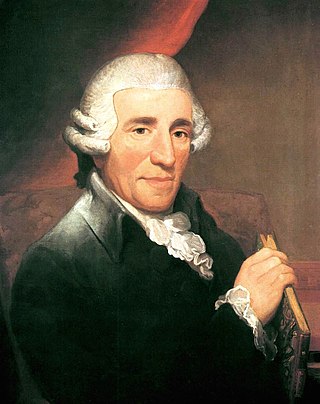Related Research Articles

The Symphony No. 100 in G major, Hoboken I/100, is the eighth of the twelve London symphonies written by Joseph Haydn and completed in 1793 or 1794. It is popularly known as the Military Symphony.
The Symphony No. 98 in B♭ major, Hoboken I/98, is the sixth of the twelve London symphonies composed by Joseph Haydn. It was completed in 1792 as part of the set of symphonies composed on his first trip to London. It was first performed at the Hanover Square Rooms in London on 2 March 1792.
The Symphony No. 97 in C major, Hoboken I/97, is the fifth of the twelve London symphonies written by Joseph Haydn. It was completed in 1792 as part of the set of symphonies composed on his first trip to London. It was first performed at the Hanover Square Rooms in London on 3 or 4 May 1792. First published in England, it made its way to the continent a few years later and was used by Ludwig van Beethoven as a model for a symphony in C major he never completed, and by Friedrich Witt for the Jena Symphony.

The Symphony No. 54 in G major, Hoboken I/54, is a symphony by Joseph Haydn, composed in 1774.
Michael Haydn's Symphony No. 29 in D minor, Opus 1 No. 3, Perger 20, Sherman 29, MH 393, written in Salzburg in 1784, is the only minor key symphony he wrote. It is the first of four D minor symphonies attributed to Joseph Haydn.
Michael Haydn's Symphony No. 20 in C major, Perger 12, Sherman 20, MH 252, written in Salzburg in 1777, is one of the few of his symphonies to have a slow movement in a minor key, and one of his few C major symphonies to not include trumpets or timpani.
Michael Haydn's Symphony No. 7 in E major, Perger 5, Sherman 7, MH 65, written in Salzburg in 1764, is one of the few symphonies in E major written in the 18th century, and was the first of four symphonies in the key to be mistaken for a symphony by Joseph Haydn.
Michael Haydn's Symphony No. 5 in A major, Perger 3, Sherman 5, MH 63, written in Salzburg in 1763, is the third of twelve symphonies in the key to be mistaken for a symphony by Joseph Haydn.
Michael Haydn's Symphony No. 36 in B-flat major, Perger 28, Sherman 36, MH 475, written in Salzburg in 1788, is the last B-flat major symphony he wrote, the third of his final set of six symphonies.
Michael Haydn's Symphony No. 9 in D major, Perger 36, Sherman 9, MH 50, was written in Salzburg in 1766. It is the 21st D major symphony attributed to Joseph Haydn in Hoboken's catalog.
Michael Haydn's Symphony No. 38 in F major, Perger 30, Sherman 38, MH 477, written in Salzburg in 1788, is the next to last F major symphony he wrote, the fifth of his final set of six symphonies.
Michael Haydn's Symphony No. 32 in D major, Perger 23, Sherman 32, MH 420, was written in Salzburg in 1786.

Michael Haydn's Symphony No. 23 in D major, Perger 43, Sherman 22, Sherman-adjusted 23, MH 287, is believed to have been written in Salzburg around 1779. It was attributed to Wolfgang Amadeus Mozart in Ludwig von Köchel's original catalog as K. 291.
Michael Haydn's Symphony No. 18 in C major, Perger 10, Sherman 18, MH 188, written in Salzburg in 1773, is the fifth of the C major symphonies attributed to Joseph Haydn in Hoboken's catalog.
Michael Haydn's Symphony No. 10 in F major, Perger 45, Sherman 8, Sherman-adjusted 10, MH 69, is believed to have been written in Salzburg after 1774.
Michael Haydn's Symphony No. 39 in C major, Perger 31, Sherman 39, MH 478, written in Salzburg in 1788, is the last C major symphony he wrote, the sixth of his final set of six symphonies.
Michael Haydn's Symphony No. 15 in D major, Perger 41, Sherman 15, MH 150, is believed to have been written in Salzburg after 1771. This work was at one time attributed to Joseph Haydn, the first work in D major so attributed.
Michael Haydn's Symphony No. 16 in A major, Perger 6, Sherman 16, Sherman-adjusted 17, MH 152, was written in Salzburg in 1771. This work was at one time attributed to Joseph Haydn, the ninth work in A major so attributed in Anthony van Hoboken's catalogue.

Joseph Haydn wrote Symphony No. 23 in G major, Hoboken I/23, in 1764.

Joseph Haydn's Symphony No. 15 in D major, Hoboken I/15, may have been written between 1760 and 1763.
References
- Charles H. Sherman and T. Donley Thomas, Johann Michael Haydn (1737 - 1806), a chronological thematic catalogue of his works. Stuyvesant, New York: Pendragon Press (1993)
- C. Sherman, "Johann Michael Haydn" in The Symphony: Salzburg, Part 2 London: Garland Publishing (1982): lxiii